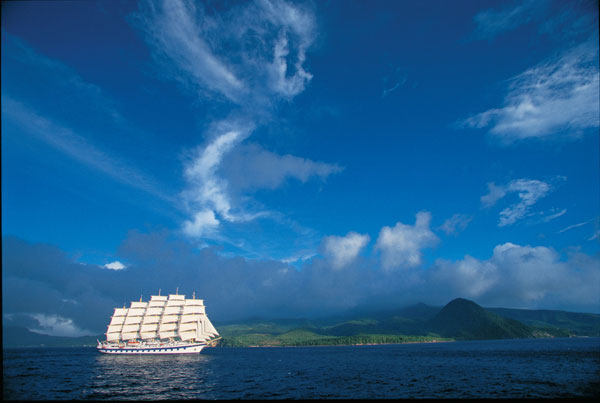It stinks, but the truth is the truth. Some forms of travel create a disproportionate amount of waste. Taking a cruise is one of them. The amount of fuel these behometh sea cities burn is astonishing, and there’s little that saving back linens or using animal-friendly shampoo can do to stop the waste it produces. There are, however, a wide range of less destructive options that will leave your conscience feeling much lighter.
Star Clippers

Star Clippers’ sailing cruises provide a similar experience to a major cruiseline without the pollution, crowds or the limitations of a ship the size of Manhattan. While there are engines installed for when the wind dies down, the focus on Star Clippers is the fact that you’re using wind power. Burning less fuel greatly reduces a ship’s impact on the air and water around them. It also burns a higher quality of fuel while using energy power, helping them to become the first cruise company to receive the International Air Pollution Certificate.
An additional benefit that big ships can’t come close to pulling off? Smaller ships can dock at dozens of sites big ships can’t reach. The communities, the artifacts and the natural areas you have access to aboard one of these vessels makes you wonder why people don’t demand a smaller ship to begin with.
Possibly the nicest feature is the significantly smaller passenger list. Where a traditional ship can carry 5000 travelers, Star Clippers cap out around 175. They make the same voyages as the larger ships, and at a slightly reduced price. The typical 7-day cruise costs $2000 – $5000 depending on room selection. Why wouldn’t you opt for one of them?
Lindblad Expeditions

When National Geographic branched off into adventure travel, there was one cruising company that caught their eye. Lindblad’s commitment to sustainability and travel philanthropy can’t be beat, although it is wrapped into the cost. While passenger sizes range from 30 – 150, which is not much less than Star Clippers, the additional costs for adventure activities, and concentrating on causes in each area, almost doubles the expense.
It’s worth it for travelers who want access to experienced guides – qualified naturalists and historians trained with National Georgraphic – equipment and opportunity for some of the best outdoor activity of your life, and the rare chance to be part of a larger project that has significant impact.
Lindblad’s trips to the Galapagos have raised over $4.5 Million for efforts there. Because of their financial contributions in certain places, Lindblad has also built connections in communities to give you access to sites others only dream about.
Regent Seven Seas Cruises

While Regent pays particular attention to their waste and water management programs onboard, it really is their Circle of Interest cruises for young guests and their parents that put them on the list. These specialized cruises take children into wildlife areas to teach and encourage care for the wild flora, and fauna. These eco-excursions embody Regent’s environmental concious take on the cruise industry.
Orion Expedition Cruises

Orion stands out as an adventure cruise line with an emphasis on preserving the habitats they visit. Their smaller ships have access to some of the most protected environments and secluded settlements on the planet, and they’re happy to take you there for a price. Their luxury adventure cruises provide guests with intimate, luxury explorations.
Onboard, guests will have access to land and marine experts, park rangers and qualified guides. The ships themselves are fitted with award-winning waste management facilities, and land excursions follow strict guidelines to protect and preserve the local environments.
Disney Cruise Line

Both Disney and Nickolodean offer their own cruise lines heading to traditional – and not so traditional – Ports of Call. Between the two companies, Disney goes the extra mile in protecting the environment. The cruise line takes an innovative approach to using less water and energy, setting industry-wide trends that have reduced pollution and waste for everyone. In addition, Disney carries on an intensive environmental education program, and accompanying wildlife conservation fun which, to date, has raised upwards of $10 Million.
Over 30 percent of the water used on Disney cruiseships comes from condensation in the air conditioning system. Heat created by the engine’s boilers is used in making potable water from saltwater. They were also the first company to use a non-toxic hull coating to cut down friction, and in doing so, fuel usage.
Plus, they have their own private, pirate-themed island! How cool is that? Off the shore of Castaway Cay, Pirates of the Caribbean enthusiasts can enjoy a true-to-size model of the Black Pearl. Castaway Cay has its own environmental protection policy in place, too. Disney works hard not only to keep it safe and healthy for the human visitors there, but the wildlife that makes the island their home.
Many thanks to the individual cruise lines, as well as Cruise Critic for help in learning more about the options available for today’s travelers, and which companies are going above and beyond to meet those needs. Whether someone is searching for an out-of-the-way experience that is hands-on and actively helps the environment, or a typical cruise that doesn’t make quite the impact of other companies, our list of five eco-friendly cruise alternatives will come in handy.
Have you been on a cruise? What do you think of them?
Image Credits: Star Clippers / Lindblad Expeditions / Regent Seven Seas Cruises / Orion Expedition Cruises / Disney Cruise Line
